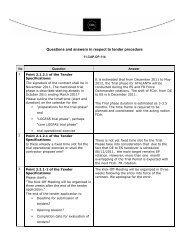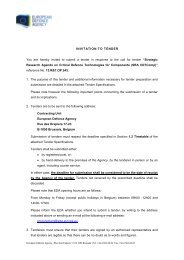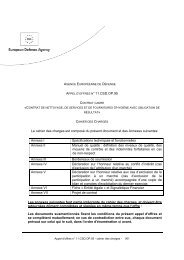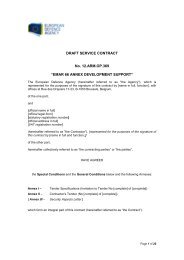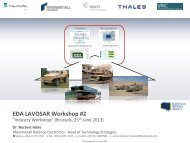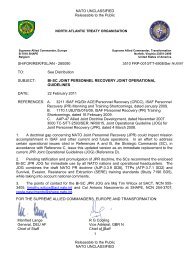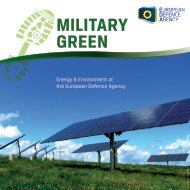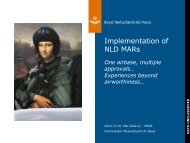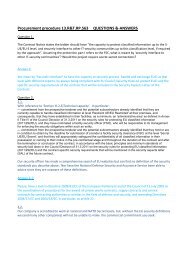capability development plan - European Defence Agency - Europa
capability development plan - European Defence Agency - Europa
capability development plan - European Defence Agency - Europa
You also want an ePaper? Increase the reach of your titles
YUMPU automatically turns print PDFs into web optimized ePapers that Google loves.
THREATS AND CHALLENGES DERIVING FROM<br />
POTENTIAL ADVERSARIES<br />
53. The integrated fight will be literally close, quick, and violent. Leaders will have minimal decisionmaking<br />
time. Failure to recognise adversaries' intent and then act is likely to be fatal.<br />
57<br />
54. Adversaries will have access to modern and sophisticated air defence systems including Surfaceto-Air<br />
Missiles, Directed Energy Weapons (DEW), and electronic attack systems (EW, DEW).<br />
Adversaries' increased access to electronic attack systems (EW, DEW) is likely to hamper, in<br />
particular, the use of High Value Assets like AEW and AAR aircraft (e.g. jamming communication and<br />
navigation systems).<br />
55. EU forces’ SEAD capabilities may be challenged by adversaries' use of a broad spectrum of<br />
combination of old and new and technologies (ad hoc hybrid solutions, dispersed command and<br />
control).<br />
56. Adversaries' predicted use of CBRN weapons and devices may require the EU force to operate in<br />
contaminated areas for longer periods of time.<br />
57. Due to enhanced mobility of adversary the area of operations is likely to be extended and thus<br />
may augment the effort required for Force Protection.<br />
58. Adversaries may be able to counter EU forces’ non lethal capabilities.<br />
59. Adversary’s access to long range guided precision weapons will increase need for site defence<br />
capabilities.<br />
60. Adversary’s tactics in the urban environment will reduce the advantage in range and accuracy of<br />
stand-off PGMs. In this form of close interaction, long-range, airborne-launched weapons would be of<br />
limited use because of the proximity of friendly forces and the scarcity of significant targets. This is<br />
likely to require attack helicopters or other aircraft to move in closer to strike with the associated risks.<br />
61. Adversaries will have access to sophisticated AAM (Beyond Visual Range Missile) giving them the<br />
ability to engage aircraft, which for example, will allow them to enter no fly zones to intercept support<br />
aircraft such as AAR.<br />
62. Adversaries’ access to ManPADS and other air defence systems will pose elevated threat to<br />
helicopters and other low-level flying aircraft, incl. UAVs. It may even pose a significant threat to<br />
medium and high level aircraft.<br />
63. Adversaries may try to saturate air space management system with small targets. Increased use of<br />
© sxc.hu<br />
UAVs will complicate airspace control and management. Identification of Friend or Foe will be more<br />
challenging.<br />
64. Adversaries will develop electronic warfare capabilities and cyber attack capabilities that are likely<br />
to be used to deny EU forces’ ability to control airspace. Adversaries’ access to new technologies<br />
(stealth etc.) will contribute to this.<br />
65. The modern sophisticated logistics applications and technologies and increased number of<br />
specialist contractors (civilians) within the EU forces will provide the adversaries with plenty of high<br />
value targets. For example, pipelines, which are rather arduous to monitor and protect, may become<br />
more attractive targets for adversaries.<br />
66. There may be limited possibilities to get HNS due to potential infiltration and other actions of<br />
terrorists and insurgents.<br />
POTENTIAL CAPABILITY CHARACTERISTICS OF GENERIC REGULAR AND IRREGULAR<br />
ADVERSARIES<br />
For the sake of the CDP Strand B Workshops only, the EDA developed a system of classification of<br />
<strong>capability</strong> in order to categorise potential adversaries using a wide range of factors. This is to provide a<br />
generic assessment of the possible capabilities of differing potential adversaries by extrapolating data<br />
based on the assessment of each. For ease of analysis each potential adversary is categorised as 1, 2,<br />
or 3.<br />
FUTURE TRENDS FROM THE CAPABILITY DEVELOPMENT PLAN




